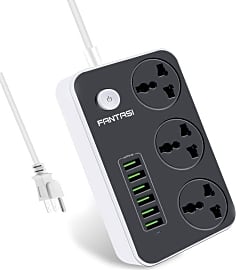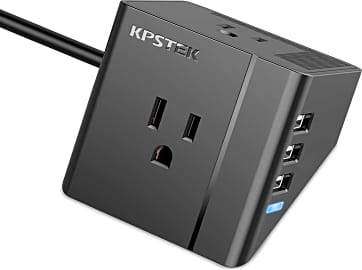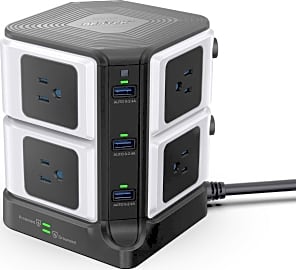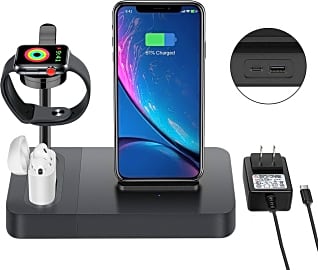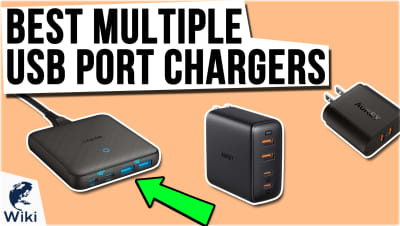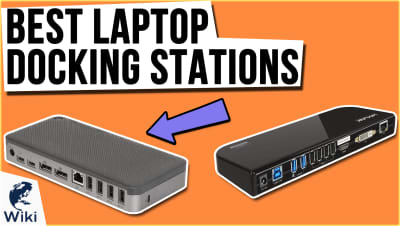The 10 Best Power Docks

This wiki has been updated 42 times since it was first published in September of 2015. There are rarely enough wall outlets to run all of our peripherals and mobile devices these days, and constantly bending over to remove or replace a plug is inefficient and tough on your back. With a range of connectors and capacities, one of these power docks will be the hub you need, bringing enough electrical current to your desktop, table or counter to recharge nearly any battery. When users buy our independently chosen editorial choices, we may earn commissions to help fund the Wiki.
Editor's Notes
July 08, 2020:
There are a few types of of products that can deliver power effectively to multiple devices or while also performing other useful functions. The simplest are those like the RavPower PC029, which is essentially just a multi-port USB charger and while it's not very fancy, it does a great job at what it's designed for. The Poweroni PCS6 is similar, except it also provides a place to store electronics while you're topping them up.
There are a lot of worthwhile choices that offer AC and USB outlets, such as the iClever Power BS03, Fantasi FA1701, and KPStek KS2312, which are all relatively affordable. The Belkin Conference Room and Bestek MRJ8008 are significantly more expensive but provide reliable surge protection that could save the day in the wake of an electrical storm or failed wiring.
Then there are a couple powered laptop docking stations that are very much worth mentioning. The Sabrent DS-WSPD is quite capable and offers plenty of expansion options, but the Vava DK004 is even more useful as it's able to pump out enough juice using the Power Delivery protocol to drive any laptop on the market.
Power For The Whole Family
Most power docks come equipped with at least two or three AC plugs and multiple USB ports for convenient charging.
Take a moment to think about how many electronic devices you use throughout your day. How many does your household own? The average family could have anywhere from five to ten electronic devices in their home at one time. You might personally use three or four per day between your laptop, your phone, your tablet, and your iPod or MP3 player.
If you are on this page, you already know how frustrating it can be to try to constantly locate the appropriate charger and set your device to charge. If you are as connected as most of the world, you also know what it’s like to be caught with a low battery and scramble to find the charger before your phone powers down.
That’s why power docks have come to the rescue. They add convenience and prevent you from having to search through a door of multiple power cords to find the one you need.
Most power docks come equipped with at least two or three AC plugs and multiple USB ports for convenient charging. There are some that can even charge your device wirelessly so you don’t have to worry about finding a cord that fits at all.
Ranging in material from plastic to leather to Eco-friendly bamboo, it is not difficult to find a power dock that supports the necessary number of devices while fitting the style of your home or office. Some even look like standard office accessories that can also hold papers and file folders for added convenience. Most have LED indicator lights that show when a device is charging and the power station is working properly.
Because You Need More Power
Since you are likely attempting to keep multiple devices charged each day, you could opt for the classic surge protector (otherwise known as a power strip). But that’s a huge pain when dealing with all of the AC adapters and cords and can ultimately result in a huge mess.
The right power dock can cut back on the clutter and simplify your life, keeping all of your devices charged and in one easy place. But what factors should you consider before buying?
You might want to invest in a power dock with a few more ports than you actually need right now just in case you add more devices down the road.
First, look for UL Certification. This should be a deal breaker when buying your first power dock. Many of them on the market are cheaply made, can damage your device, and can present fire hazards. A power dock with a UL Certification is considered safe and energy efficient.
Second, you have three form factors to choose from. This decision is often based on personal preference depending on where and how you plan to use your power dock. You can choose from a wall charger with multiple USB ports that plugs directly into the wall; a corded hub that plugs into the wall but has a cord that allows it to sit on your desk, counter, or nightstand; or an organizer that not only has USB ports but will hold your devices as well. The organizers are great for office use or for homes that use multiple devices of varying sizes and types.
The third step may be obvious, but consider the number of ports you will need. Count your devices and determine if you will need multiple USB and AC ports to charge all of your devices. Also, don’t forget to look ahead to the future. You might want to invest in a power dock with a few more ports than you actually need right now just in case you add more devices down the road.
Finally, consider how fast the power dock generally charges devices. This is known as port amperage. Larger devices such as laptops and tablets will generally take longer to charge than the average smartphone or MP3 player. Some power docks are specifically designed to charge certain devices (such as Androids) faster than others. Make sure that the one you choose has a variety of charging capabilities and can power a laptop just as well as a smartphone.
A Brief History of the Power Dock
The power dock came into being when people began to live for their electronics. Laptops, MP3 players, smartphones, tablets, netbooks - all of these things became integral parts of daily life, and people were losing cords and running out of places to charge them.
The power dock came into being when people began to live for their electronics.
The power dock is a fairly recent invention and plays off the concept of the power strip for AC power connection. While inventions for charging multiple devices have existed for a number of years, very few have offered the convenience and versatility of modern day power docks.
In 2008, Paul P. Griffin, Jr filed a patent for a “multiple device charging station with user friendly configurable mount.” This station could charge two devices at one time in a standing position allowing the user to continue to access the content on the device while it charged. It also came with adapters to charge several different types of devices from iPhone to Android and beyond.
As USB chargers became the norm with smartphones, tablets, and other devices, the need for more durable power docks that could support three or more devices at one time became more prevalent. Soon, universal power stations began to hit the market and are now a common staple in many homes and offices today.





